Tom Kepler's Blog, page 2
December 12, 2022
A Neighborhood Buck in a Bit of Trouble
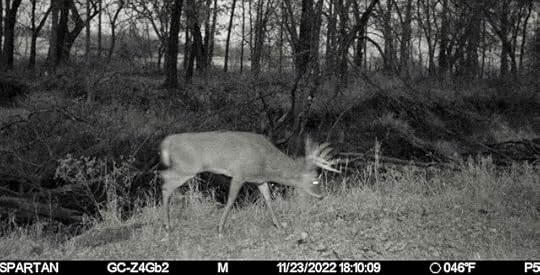 Trail camera night photoMy wife and I own our thirty-five acres of woodland and bottom land--we've got the title and it's all legal. However, for most of our neighbors, that title means nothing, neighbors we occasionally see but most often only see hints at their presence. Whether is a glimpse of a whitetail deer's tail as it leaps a barbed wire fence, the snakelike trace of a muskrat's tail in mud, or the tiny, almost-human print of a raccoon's paws at the creek side, we share our land with the animals that "possess" it as much if not more than we do. These neighbors aren't limited by property lines or signs proclaiming no trespassing or hunting. Their territory is determined by creek and ridge and hollow, by sunlight and acorn drop and seed set. Our most common neighbors are "wild" animals, although their behavior often is more predictable and reasonable than that of many humans.
Trail camera night photoMy wife and I own our thirty-five acres of woodland and bottom land--we've got the title and it's all legal. However, for most of our neighbors, that title means nothing, neighbors we occasionally see but most often only see hints at their presence. Whether is a glimpse of a whitetail deer's tail as it leaps a barbed wire fence, the snakelike trace of a muskrat's tail in mud, or the tiny, almost-human print of a raccoon's paws at the creek side, we share our land with the animals that "possess" it as much if not more than we do. These neighbors aren't limited by property lines or signs proclaiming no trespassing or hunting. Their territory is determined by creek and ridge and hollow, by sunlight and acorn drop and seed set. Our most common neighbors are "wild" animals, although their behavior often is more predictable and reasonable than that of many humans. Purchasing a trail camera that is connected to our phone plan has provided us a much better awareness of the animals that live on our land. The photos sent to us via our cellphone plan do give us a real-time glimpse into wild animal activity even though we have bought and mounted the cam primarily to determine if any cattle have escaped our neighbor's pasture. Our joke has been one steer saying to the other, "Why you want to escape and get over on their land? Our farmer's been treating us right, feeding us regularly. Why, he's even been fattening us up lately!" We haven't digitally captured any strays yet, but we have managed to catch images of a number of deer, a raccoon, a fox, and a heron with the trail camera, although most images are infrared taken at night.
Sometimes the image of an entire deer has been captured, and sometimes only a portion of the deer--the head of a spike buck, an ear, the south end of a doe heading north. Once a photo displayed no deer at all, only a landscape with some brush to the fore, and then we realized that the "brush" were the antler tines of a buck passing close to the camera. That was when we realized we had a good-sized buck that regularly spent time on our land. We became used to seeing images of the buck crossing our bottom land down by the creek. He became our most photographed citizen, with both black-and-white nighttime images and colorful daytime portraits.
Fall had arrived and deer had begun moving more, mating season and hunting season causing a stir, and that's the time when our neighborhood buck got himself into a bit of trouble. I'd been down at our bottom land along the creek with our tree guy, working on a plan to both clean up the creek of deadfall and to determine the run of a barbed wire fence to create a north pasture area. We walked the creek and checked out the places where fence crossed the creek, the weakest spots and most likely places for cattle to breach the fence. We made our plan, and I walked the man up the hill to his truck.
Heading back down the easement that skirts the gravel road a half hour later, the scene of meadow, creek, and bridge had altered; adding to the bucolic peace was our buck, he head stuck through the barbed wire fence and his antlers firmly trapping him between the strands. Well, there go my plans for the afternoon, I thought, realizing that I needed to rescue the animal.
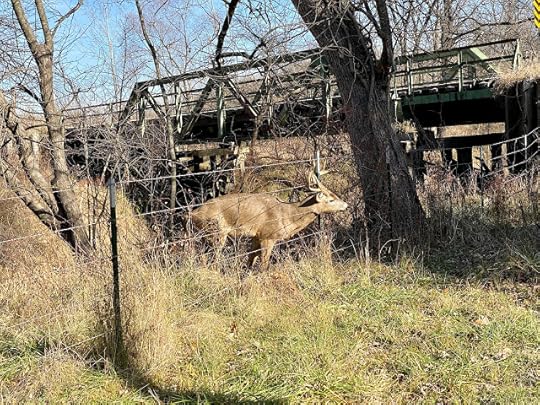 Buck caught in barbed wireI approached the buck and saw that it probably was the mature animal that our trail cam had photographed. Up close, my first impression of the animal was how solid and muscular its neck, chest, and shoulders were. Its neck was faintly colored with a red streak of blood where it had fought the wire. As I approached, the buck began to fight the wire, attempting to escape, jerking its head from side to side as it tried to back away from the fence, the wire bowing and the steel fence post loosening in the ground. I stopped, realizing the animal was increasing its injury, and as a new landowner realizing this animal was strong enough to destroy the fence.
Buck caught in barbed wireI approached the buck and saw that it probably was the mature animal that our trail cam had photographed. Up close, my first impression of the animal was how solid and muscular its neck, chest, and shoulders were. Its neck was faintly colored with a red streak of blood where it had fought the wire. As I approached, the buck began to fight the wire, attempting to escape, jerking its head from side to side as it tried to back away from the fence, the wire bowing and the steel fence post loosening in the ground. I stopped, realizing the animal was increasing its injury, and as a new landowner realizing this animal was strong enough to destroy the fence. I back away and considered what to do. Deciding first to talk to my neighbor who I knew was a hunter, I jumped into my UTV and jammed to his house, following the gravel road across the bridge. He wasn't home, though. Next I tried to call the local state Department of Natural Resources but received no reply. Deciding that the sheriff's office was my last resort, I called, and the dispatcher took my information but wasn't too enthused. Texting a message and photo to my wife, she contacted our neighbor--yes, the one who had been so negative to me the first time we met--and then texted me back that our neighbor was on his way, a quick message considering that the communication trail had been from me to my wife to the neighboring farmer's wife to the farmer himself. No direct link to Mr. Curmudgeon.
I arrived from camp back down the hill to the trapped buck to find my neighbor approaching the animal, which jerked at the fence mightily until my neighbor laid his hands on the animal, which then froze, not moving. Then with some jerking and pulling, the buck was free. As I walked down the hill toward man and deer, I saw that the buck wasn't moving but was just standing by the fence, still imagining that it was entwined in the barbed wire, I suppose. My neighbor shooed at it, and then it backed off and leapt down the creek bank and crossed beneath the bridge, following the stream bed to freedom. I saw that my neighbor had some scratches on the back of one hand--more blood given to the land.
This was my chance to thank my neighbor, who was the hero in this little adventure. After shaking his hand and providing thanks, he said, "I've been doing this for fifty years. It may seem heartless for you to hear, but I do it as much to save the fence as the animal." I replied that I understood, having seen how the buck had almost jerked a fence post loose when I had first approached the trapped animal.
I felt glad that the buck had been saved--and the fence--and that an opportunity had been provided for my neighbor and me to have one more interaction that was positive overall. Trust can be gained bit by bit over time, with patience and understanding. That's my hope, at least.
"I tried DNR first and then the sheriff's office," I said. "A deputy come out to help?" he asked. When I replied in the negative, he just chuckled. "Yeah, they didn't sound like they were coming with sirens screaming," I said. It was, after all, deer season, and the DNR in Iowa plans for between a hundred and a hundred twenty thousand deer to be harvested each year. A deer stuck in a fence? That's probably right up there with someone calling in saying there have been some old tires dumped along the road.
We're not at the end of the story, though. As my neighbor was driving off in his UTV, he stopped and gestured me over, saying that the buck was stuck in a thicket of multiflora across the road. These wild roses thickets can be brutal, and evidently the buck after his barbed wire experience psyched himself into thinking the thorns of the multiflora were barbed wire. My neighbor asked if we should shoo the buck out of the thorn patch.
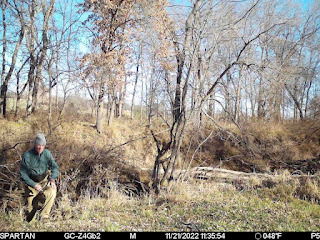 Early photo of me setting up the trail cam"He can get out of that," I said. "It's not like the barbed wire." I was thinking that this is a big buck during rutting season, and that now there was no barbed wire fence between us if it decided to get aggressive. My neighbor approached the buck again, though, and before he got close, it moved out of the multiflora and away, down the creek. We chatted for a bit while on the road at the bridge, the mailman stopped and chatted for a bit with us, and then we all went on our way.
Early photo of me setting up the trail cam"He can get out of that," I said. "It's not like the barbed wire." I was thinking that this is a big buck during rutting season, and that now there was no barbed wire fence between us if it decided to get aggressive. My neighbor approached the buck again, though, and before he got close, it moved out of the multiflora and away, down the creek. We chatted for a bit while on the road at the bridge, the mailman stopped and chatted for a bit with us, and then we all went on our way. Later I phoned my wife, and she said that the farmer's wife had texted reassurance, that everything would be okay. She was right! We had all cooperated in a neighborly way, and the buck had escaped the danger of the barbed wire just in time to deal with the opening of the shotgun segment of deer hunting season. I wonder now, a couple of weeks later as I write this narrative, how that buck has fared. He may be free, he may be venison for some hunter, food for the table, but at least he isn't stuck in that barbed wire fence, suffering his way toward a cruel death. We do what we can and let the wide ways of the world roll on. It's a good world, in part because of good intentions and unexpected heroes, some of whom arrive in a muddy UTV, wearing blue denim and Carhartt canvas. Actions speak more loudly than words.
Note: This is one of a series of articles written about the thirty-five acres of land my wife and I own in southeast Iowa. To read all the articles, go to the label link aggregate provided here: Landowner.
 #mc_embed_signup{background:#fff; clear:left; font:14px Helvetica,Arial,sans-serif; } /* Add your own Mailchimp form style overrides in your site stylesheet or in this style block. We recommend moving this block and the preceding CSS link to the HEAD of your HTML file. */ Follow by Email* indicates required Email Address * First Name Last Name (function($) {window.fnames = new Array(); window.ftypes = new Array();fnames[0]='EMAIL';ftypes[0]='email';fnames[1]='FNAME';ftypes[1]='text';fnames[2]='LNAME';ftypes[2]='text';fnames[3]='ADDRESS';ftypes[3]='address';fnames[4]='PHONE';ftypes[4]='phone';}(jQuery));var $mcj = jQuery.noConflict(true);
#mc_embed_signup{background:#fff; clear:left; font:14px Helvetica,Arial,sans-serif; } /* Add your own Mailchimp form style overrides in your site stylesheet or in this style block. We recommend moving this block and the preceding CSS link to the HEAD of your HTML file. */ Follow by Email* indicates required Email Address * First Name Last Name (function($) {window.fnames = new Array(); window.ftypes = new Array();fnames[0]='EMAIL';ftypes[0]='email';fnames[1]='FNAME';ftypes[1]='text';fnames[2]='LNAME';ftypes[2]='text';fnames[3]='ADDRESS';ftypes[3]='address';fnames[4]='PHONE';ftypes[4]='phone';}(jQuery));var $mcj = jQuery.noConflict(true);
November 21, 2022
Snow Falls and the World Changes
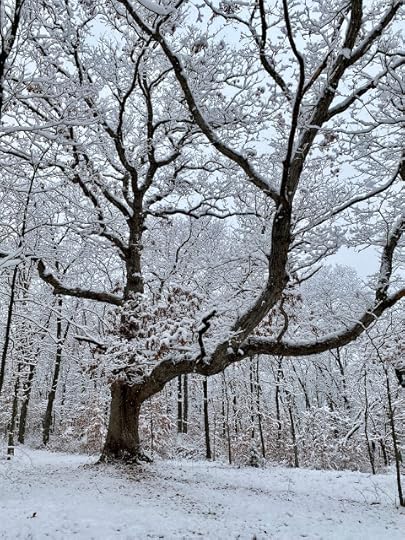
We awake to a cold, clean silence, a remembrance that if silence could have a color, it would be white crystals of snow drifting their serene journey to the earth. This pristine white, this cold, clean silence was our first snowfall on the thirty-five acres my wife and I now own, and we celebrated the morning with a walk cradled in quiet contemplation of the beauty surrounding us. The trees were draped with snow which accumulated and fell in feathery clumps--one down my neck, providing an early-morning wake-up! Our footprints painted the canvas of the snow as side by side Sandy and I walked the familiar yet newly-created trails across ridges and down hills to the bottom land.
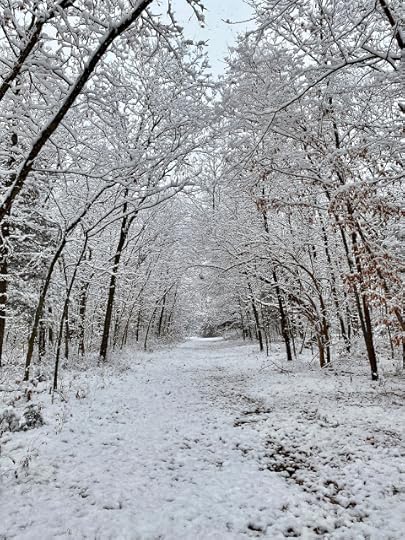
Ours were the only tracks on the land, the animals we shared the land with bedded down. No squirrels chattered at us, hiding behind the gray, shaggy bark of hickory trees. No ground hogs lumbered across the gravel to the safety of brush across the drive. We had evidence in our Airstream Basecamp travel trailer that a mouse had moved in, and Sandy, while sipping her morning tea, had even seen the little critter moving around behind a smoked plastic cabinet door in the kitchen area. It was a quiet morning, though, and would be a quiet day, the insulating blanket of snow absorbing and muffling sound until it slowly melted as the morning advanced to afternoon.
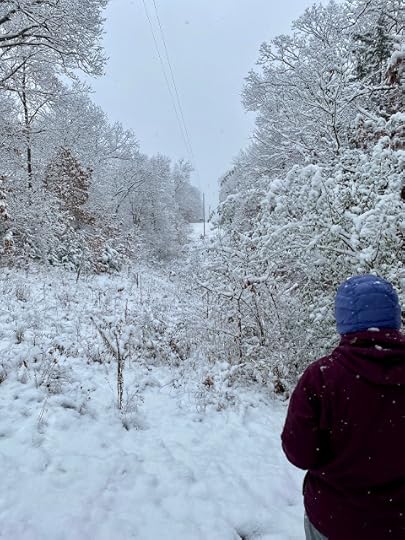
That evening we sat outside beside our campfire, enjoying the crackling of the fire that accentuated the silence of the evening. It was then that we shared a moment on the land with a creature other than ourselves--and that wild citizen of the woods turned out to be a spotted white and gray domestic cat, some neighbor's pet ranging wide and making its way to us. We called to the cat but it would not approach, staying tucked safely and half-hidden at the base of a tree about thirty yards away. Sandy stood and approached the cat, calling reassuringly, but the cat, although curious, was also cautious and slid away into the darkness. Perhaps it will be more trusting with its next visit.
Wilderness writers have described the "cathedral of the forest," the forest as a place to awaken the spirit or to enliven the spirit on the level of the senses. The bare limbs of trees or the umber of oak still retaining fall's russet splendor; all the shades of autumn's fallen leaves that carpet the forest floor; the rich smell of the moist earth; the sharp, cold breath of wind as it whispers across the crowns of the trees; the swaying of limbs and the hollow, sodden sound of clumps of snow falling from sun-warmed branches--to be a part of this morning, this first snowfall--to be a part of this world rather than a stranger who intrudes--this means all the world to me. It puts me in my place, where I feel at home, reassured by the continuity and continual rebirth of existence. There is no ending that there is a beginning, no heartbeat without the silence between. The unique beauty of a snowflake drifts the silent sky and falls upon a tree branch. I see that beauty, a frozen moment in time, and become it. The world is still, the sun shines, and for a timeless moment I am wondrously at ease, fulfilled to simply be.
 #mc_embed_signup{background:#fff; clear:left; font:14px Helvetica,Arial,sans-serif; } /* Add your own Mailchimp form style overrides in your site stylesheet or in this style block. We recommend moving this block and the preceding CSS link to the HEAD of your HTML file. */ Follow by Email* indicates required Email Address * First Name Last Name (function($) {window.fnames = new Array(); window.ftypes = new Array();fnames[0]='EMAIL';ftypes[0]='email';fnames[1]='FNAME';ftypes[1]='text';fnames[2]='LNAME';ftypes[2]='text';fnames[3]='ADDRESS';ftypes[3]='address';fnames[4]='PHONE';ftypes[4]='phone';}(jQuery));var $mcj = jQuery.noConflict(true);
#mc_embed_signup{background:#fff; clear:left; font:14px Helvetica,Arial,sans-serif; } /* Add your own Mailchimp form style overrides in your site stylesheet or in this style block. We recommend moving this block and the preceding CSS link to the HEAD of your HTML file. */ Follow by Email* indicates required Email Address * First Name Last Name (function($) {window.fnames = new Array(); window.ftypes = new Array();fnames[0]='EMAIL';ftypes[0]='email';fnames[1]='FNAME';ftypes[1]='text';fnames[2]='LNAME';ftypes[2]='text';fnames[3]='ADDRESS';ftypes[3]='address';fnames[4]='PHONE';ftypes[4]='phone';}(jQuery));var $mcj = jQuery.noConflict(true);November 12, 2022
Just Being Neighborly
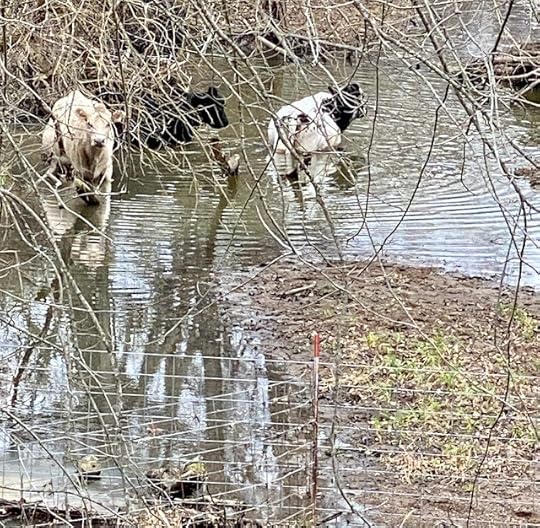 "I'm an angry man" were the first words my neighbor spoke to me when I first met him. He had pulled his ATV up onto my gravel in front of my travel trailer, dismounted, and settled himself, both legs solidly planted. His last words an hour and a half later were "And this is the last time I'll ever speak to you."
"I'm an angry man" were the first words my neighbor spoke to me when I first met him. He had pulled his ATV up onto my gravel in front of my travel trailer, dismounted, and settled himself, both legs solidly planted. His last words an hour and a half later were "And this is the last time I'll ever speak to you."First of all, even though he said he was angry, he never seemed all that angry in his composure or speech patterns, no livid face or spitting while he was speaking. If he was angry, he wasn't mad-dog angry, perhaps more a habitual state of mind. To me he was more bitter--and certainly confrontational. It's sad that one of America's small farmers carries such unhappiness in his heart.
Ten Reveals from Our Conversation:"My wife told me to be nice when I talk to you." (Good idea.)"I'm not your neighbor. We just own adjoining land." (Well, I'm going to try to be a good neighbor.)"I see you've got a No Trespassing sign posted. You're from California, aren't you?" (Our insurance agent suggested the sign, and, yes, I lived in California 43 years ago.)"What gives you the right to buy this land? You're just driving up property prices." (We paid the asking price, actually lower than other comparative properties.)"So your wife's got a successful business?" (Yes, she does. Are you mean-mouthing my wife?""My cows have gotten onto your land. What are you going to do about it because it's not my problem." (Then why are you here talking to me?)"He [a mutual business acquaintance] told you that? He's a liar!" (Hmmm?!)"I can't believe you still aren't arguing with me!" (And I don't intend to. How would it help anything?))"You can't solve anything about the cattle getting out, what with flooding and erosion at the creek fence. And I won't help you." (If it's a continuing problem, then working together is even more important.)"Well, if you want to, we can go down, and I'll help you get those cows back where they belong." (I really appreciate any advice and direction you can give me.)I did speak with my neighbor a second time, though, no matter his words. I flagged him down as he was idling down the road in his side-by-side UTV, exercising his dogs. This time, I remembered and utilized the Mark Twain quote: It's hard not to like someone who loves your work, your children, or your dogs." And it just so happens that I do like dogs.
"Those are good-looking hounds you've got there. These are the ones you take to coyote-hunting competitions?" The next thing I knew, I was looking at photos on his phone of his dogs at competitions, and learning that the next competition would be in Missouri in a couple of weeks. As my neighbor drove off to continue exercising his dogs, I felt that the conversation had been fairly pleasant, with whatever negativity that arose directed not at me--more a chewing of old bones, to continue the dog metaphor. I was able to provide some updates on our progress regarding our property's fences and cattle containment without unduly tripping any emotional triggers. A few days later, I saw him in his field, spraying multiflora, and I'm happy to say he waved at me--a low-key wave, but nonetheless, he waved!
In the end, I've decided that my neighbor is always welcome on my land, as long as he comes in peace; and it also seems fair that if I expect my neighbor to peacefully interact with me that I also have peace in my heart. We owe it to ourselves, and we owe it to the land.
 #mc_embed_signup{background:#fff; clear:left; font:14px Helvetica,Arial,sans-serif; } /* Add your own Mailchimp form style overrides in your site stylesheet or in this style block. We recommend moving this block and the preceding CSS link to the HEAD of your HTML file. */ Follow by Email* indicates required Email Address * First Name Last Name (function($) {window.fnames = new Array(); window.ftypes = new Array();fnames[0]='EMAIL';ftypes[0]='email';fnames[1]='FNAME';ftypes[1]='text';fnames[2]='LNAME';ftypes[2]='text';fnames[3]='ADDRESS';ftypes[3]='address';fnames[4]='PHONE';ftypes[4]='phone';}(jQuery));var $mcj = jQuery.noConflict(true);
#mc_embed_signup{background:#fff; clear:left; font:14px Helvetica,Arial,sans-serif; } /* Add your own Mailchimp form style overrides in your site stylesheet or in this style block. We recommend moving this block and the preceding CSS link to the HEAD of your HTML file. */ Follow by Email* indicates required Email Address * First Name Last Name (function($) {window.fnames = new Array(); window.ftypes = new Array();fnames[0]='EMAIL';ftypes[0]='email';fnames[1]='FNAME';ftypes[1]='text';fnames[2]='LNAME';ftypes[2]='text';fnames[3]='ADDRESS';ftypes[3]='address';fnames[4]='PHONE';ftypes[4]='phone';}(jQuery));var $mcj = jQuery.noConflict(true);August 28, 2022
When Buying Land, Do We Own a Bit of Nature?
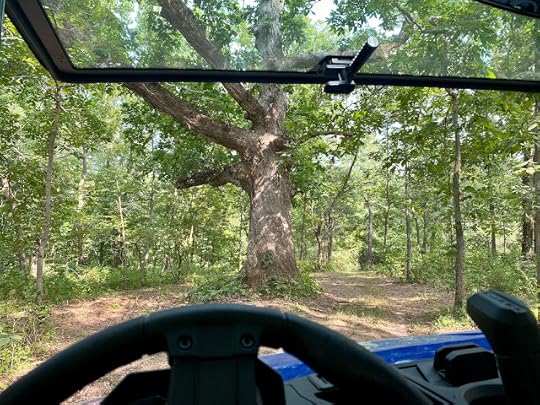
How do we own land, how do we possess it? Right now my wife and I possess legal documents that say we own thirty-five acres of farmland in southeast Iowa. The abstract for the land will be our narrative of ownership, a record of the first owners, a thread of ownership down the years. For me, I've been engaged in a process of defining my ownership of this land, and so far I've found it possible to accept the idea stewardship rather than ownership.
Our thirty-five acres are mostly defined to the north by Big Indian Creek. The defining features to the east are the county gravel road and the rural electric easement that skirts the road, a strip of land cleared of trees, threaded with power poles and lines. The land rises from that northeast corner of creek, road, and bridge uphill to the south border of our land, higher and drier ground. Most of the thirty-five acres are covered with trees, the land dropping off from the south mostly to the north and east, down to the creek. The configuration of the land on the map is roughly a rectangle, but walking the land with its several ridges and ravines still is somewhat confusing, that confusion exacerbated not only by the lay of the land but also by the thickets of multiflora rose, which inhibit straight travel. There are sections of the land we haven't seen yet because of barriers of multiflora and poison ivy. Our first impression of our stewardship of this land is that we have to begin clearing out the invasive multiflora and the noxious poison ivy. We expect this to be a never-ending battle, not one we accomplish, check off the list, and then forget about.
My first connection with the land--and I believe also my wife Sandy's--has been to the several large white oaks that extend along the east and south sides of the property--about a half dozen that are easily over a hundred years old. Two or three are truly massive, a shading, abiding, gnarled presence on the land, whose presence seems to attract (or radiate) silence and stillness. I cannot help but pause when I stand beneath either of the largest two, both on the south end of the property. I feel myself rooting to the ground, extending both into soil and into sky. Am I embracing the world, is the world embracing me? Those ancient oaks allow me, remind me, that I am more than a bundle of frenetic, scampering simian activity. I can stop, cease my busyness, and just abide--be for a time, and perhaps if I visit and share the silent existence of the oaks often enough, I can expand my sense of self and become both the tree scamperer and earth abider simultaneously.
To become one with the land is our highest sense of ownership. When ownership identifies as obligation, then our legal title to this patch of land begins to make sense to me. We humans have changed the land, shaped the face of the world. On this patch of land, I will have a chance to "unshape" the world, to rewild our bit of earth by removing that which is alien and by adding a bit of civilization by building and landscaping in a sustainable manner. I don't hike this land in the same manner as I hike in one of our state parks. Sometimes I will hike with a trekking pole, but sometimes it will be with a long-handled shovel so that I can remove multiflora root balls. Next spring I want to hike and discover blackberry patches, to mine the motherlode of morel mushrooms. I want to build a tiny eight-foot by eight-foot house that overlooks one of our small ravines, situated so that I can sit and allow the vista to take my eye to the horizon.
Camping in its purest form is the process of interacting with the land yet leaving no trace, to move across the land like a deer or a fox. The deer has its copse of trees and its form in the grasses where it sleeps and rests. The fox has its den where it waits out the storm and where it raises its kits. Sandy and I will have our little Airstream Basecamp for staying on the land, some small shelters we build to keep us dry and warm, and eventually a small home. Sometimes we'll hike with trekking poles, sometimes with shovels. I have a lot of research and learning to do. I want to learn the names of all the varieties of trees on our land. I want to learn which variety or varieties of grasses are the best seeds to spread. Most of all, though, I want to balance my civilizing and "uncivilizing" of the land with abiding on the land. I think if it as a partnership, for the more I live on the land, the land will live in me.
 #mc_embed_signup{background:#fff; clear:left; font:14px Helvetica,Arial,sans-serif; } /* Add your own Mailchimp form style overrides in your site stylesheet or in this style block. We recommend moving this block and the preceding CSS link to the HEAD of your HTML file. */ Follow by Email* indicates required Email Address * First Name Last Name (function($) {window.fnames = new Array(); window.ftypes = new Array();fnames[0]='EMAIL';ftypes[0]='email';fnames[1]='FNAME';ftypes[1]='text';fnames[2]='LNAME';ftypes[2]='text';fnames[3]='ADDRESS';ftypes[3]='address';fnames[4]='PHONE';ftypes[4]='phone';}(jQuery));var $mcj = jQuery.noConflict(true);
#mc_embed_signup{background:#fff; clear:left; font:14px Helvetica,Arial,sans-serif; } /* Add your own Mailchimp form style overrides in your site stylesheet or in this style block. We recommend moving this block and the preceding CSS link to the HEAD of your HTML file. */ Follow by Email* indicates required Email Address * First Name Last Name (function($) {window.fnames = new Array(); window.ftypes = new Array();fnames[0]='EMAIL';ftypes[0]='email';fnames[1]='FNAME';ftypes[1]='text';fnames[2]='LNAME';ftypes[2]='text';fnames[3]='ADDRESS';ftypes[3]='address';fnames[4]='PHONE';ftypes[4]='phone';}(jQuery));var $mcj = jQuery.noConflict(true);May 20, 2022
My Love/Hate Relationship with Zane Grey's Writing, Part 2
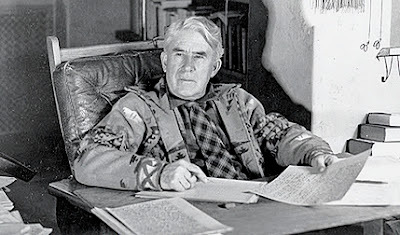 Oddly enough, "Part 1" of my love/hate relationship with Zane Grey's writing was posted on this blog twelve years ago. So in the last twelve years, have I reconciled my conflicting perspectives of Zane Grey? The short answer is no; I am still conflicted. Seeking wider perspectives, I searched for other articles about Grey's bigoted writing, the racist and sexist elements in his writing. An article posted on Literary Hub, "In Praise of Racist Books: Notes of an Immigrant Reader," drew my interest, written by Black scholar and professor Louis Clude-Sokei. (A hit on my "Part 1" Zane Grey article also was pulled up, always a hoot to find myself on the internet.)
Oddly enough, "Part 1" of my love/hate relationship with Zane Grey's writing was posted on this blog twelve years ago. So in the last twelve years, have I reconciled my conflicting perspectives of Zane Grey? The short answer is no; I am still conflicted. Seeking wider perspectives, I searched for other articles about Grey's bigoted writing, the racist and sexist elements in his writing. An article posted on Literary Hub, "In Praise of Racist Books: Notes of an Immigrant Reader," drew my interest, written by Black scholar and professor Louis Clude-Sokei. (A hit on my "Part 1" Zane Grey article also was pulled up, always a hoot to find myself on the internet.) Clude-Sukei grew up reading whatever books he could get his hands on, most of them by default White writers writing for a White audience. A first his reading simply matched his life experience--it was a bigoted, racist world he lived in, and the books he read were consistent in vision. Then Clude-Sukei grew more sophisticated and grew "to enjoy the frisson of contradiction." He writes about how "those damned racist books": "taught me that we are all shaped and rendered impure by racism, colonialism, and various forms of inequality, all the time and in all texts. Who or what we would be without those forces is unanswerable." The racism and gender rigidity in Grey's novels are historical footprints of times past (and present).
Here are a few concepts from the article that resonated with me:"I’ve [Louis Clude-Sokei] lived by Joan Didion’s evergreen dictum, 'Writers are always selling someone out.'”"Not seeing myself in any of the characters enabled me to identify with all of them, so innocence was impossible. And suspecting that the author might have been hostile to someone like me only made the dance of interpretation more exciting. This all taught me to find freedom even in narratives hell-bent on my erasure.""One can love a work of literature while vehemently disagreeing with it. This seems so obvious it’s hard to believe it must now be defended. To teach students the opposite is to hobble them with a need for innocence.""To cleanse the past, though, is not only to rob ourselves of the prickly pleasures and unique challenges of such works. More importantly, it can aid in the removal of evidence from the scene of crime.""To make sanctuary in hostile or indifferent territory is a necessary skill."
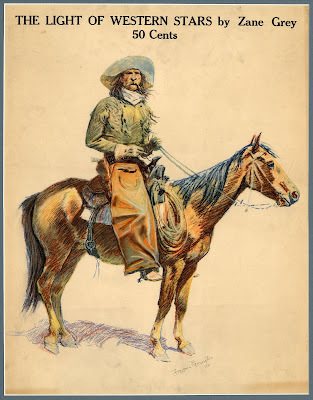
My recent foray into Zane Grey's world was his romance The Light of the Western Stars. In the novel, Madeline Hammond leaves the privileged world of the East, seeking her brother in the wilds of New Mexico, during the beginnings of the revolutionary times in Mexico in the early 1900s. She experiences the vivid roughness of the environment and the people who live there. Action includes lightning storms, fast horses, wild cowboys, gunfights, and of course love. Grey's ability to describe the Western environment is at times sublime.
Rain fell steadily. The fury of the storm, however, had passed, and the roll of thunder diminished in volume. The air had wonderfully cleared and was growing cool. Madeline began to feel uncomfortably cold and wet. Stewart was climbing faster than formerly, and she noted that Monty kept at her heels, pressing her on. Time had been lost, and the camp-site was a long way off. The stag-hounds began to lag and get footsore. The sharp rocks of the trail were cruel to their feet. Then, as Madeline began to tire, she noticed less and less around her. The ascent grew rougher and steeper—slow toil for panting horses. The thinning rain grew colder, and sometimes a stronger whip of wind lashed stingingly in Madeline's face. Her horse climbed and climbed, and brush and sharp corners of stone everlastingly pulled and tore at her wet garments. A gray gloom settled down around her. Night was approaching. Majesty heaved upward with a snort, the wet saddle creaked, and an even motion told Madeline she was on level ground. She looked up to see looming crags and spires, like huge pipe-organs, dark at the base and growing light upward. The rain had ceased, but the branches of fir-trees and juniper were water-soaked arms reaching out for her. Through an opening between crags Madeline caught a momentary glimpse of the west. Red sun-shafts shone through the murky, broken clouds. The sun had set.I enter Grey's world as an immigrant, a time traveler. The author has his "boxes" or perspectives that inform his writing: the sensitivity and intuitions "unique" to women, a "let's bash Mexicans" box, the insipid anemia of Easterners and the childlike impulsiveness of Westerners, the regenerative qualities of nature (which at times Grey romanicizes until it becomes a cliche).
I love Grey's description of the natural world, and I love his passionate characters and storylines, even with their brittle characterizations and moral binary development. As an immigrant reader, I enter Grey's novels, recognizing that I'm entering territory that will sometimes be hostile to my world view. I enjoy the frisson of being on guard, of advancing into a perspective that I at times will vehemently disagree with. Like all travelers, I advance cautiously into the "history" of the writing, the world at times beautiful and at times ugly, a stranger in a strange land--a situation not all that different, actually, from every time I walk out my front door.
 #mc_embed_signup{background:#fff; clear:left; font:14px Helvetica,Arial,sans-serif; } /* Add your own Mailchimp form style overrides in your site stylesheet or in this style block. We recommend moving this block and the preceding CSS link to the HEAD of your HTML file. */ Follow by Email* indicates required Email Address * First Name Last Name (function($) {window.fnames = new Array(); window.ftypes = new Array();fnames[0]='EMAIL';ftypes[0]='email';fnames[1]='FNAME';ftypes[1]='text';fnames[2]='LNAME';ftypes[2]='text';fnames[3]='ADDRESS';ftypes[3]='address';fnames[4]='PHONE';ftypes[4]='phone';}(jQuery));var $mcj = jQuery.noConflict(true);
#mc_embed_signup{background:#fff; clear:left; font:14px Helvetica,Arial,sans-serif; } /* Add your own Mailchimp form style overrides in your site stylesheet or in this style block. We recommend moving this block and the preceding CSS link to the HEAD of your HTML file. */ Follow by Email* indicates required Email Address * First Name Last Name (function($) {window.fnames = new Array(); window.ftypes = new Array();fnames[0]='EMAIL';ftypes[0]='email';fnames[1]='FNAME';ftypes[1]='text';fnames[2]='LNAME';ftypes[2]='text';fnames[3]='ADDRESS';ftypes[3]='address';fnames[4]='PHONE';ftypes[4]='phone';}(jQuery));var $mcj = jQuery.noConflict(true);
April 3, 2022
Upping My Travel Writing Game
 Guyana Highlands of South America"Tom, why don't you plan out a route to California?" My wife Sandy asked me this question after lunch last week--when we had been planning a camping trip that same morning to an Iowa state park a half hour's drive away. That required a shift in mental gears, I can tell you--not a bad shift but certainly a significant change of perspective!
Guyana Highlands of South America"Tom, why don't you plan out a route to California?" My wife Sandy asked me this question after lunch last week--when we had been planning a camping trip that same morning to an Iowa state park a half hour's drive away. That required a shift in mental gears, I can tell you--not a bad shift but certainly a significant change of perspective!By happenstance, my step-daughter had recently given me the new issue of National Geographic magazine, the April issue, and I was reading the article "Up the Mountain, to a World Apart," about a "venture into a remote part of Guyana with no roads and no guarantee of getting out" to a region of "sheer-sided, flat-topped mountains known locally as tepui." A scientific expedition would climb these unpopulated, untrammeled environmental time capsules to learn more about the process of evolution.
Reading the article was an eye-opener for me, a reminder of just how powerful and immediate travel writing can be. The opening paragraphs place the reader right next to conservation biologist Bruce Means.
"Grasping a sapling in one hand for balance, Bruce took a shaky step forward. His legs quivered as they sank into the boggy leaf litter, and he cursed his 79-year-old body. At the beginning of this expedition, Bruce had told me that he planned to start slowly but would grow stronger each day as he acclimated to life in the bush."Later in the article, writer Mark Synnott places us deeper in the bush, describing the conditions that the explorers were facing.
"For days we'd been trudging across a swampy floodplain through ankle-deep mud that almost sucked our boots right off our feet. It rained incessantly, and even when the sun poked through the low clouds, it never penetrated the dense canopy overhead. Down in the steamy understory, mosquitoes and biting flies reigned, and our sweat-soaked clothes, slick with mud and ripped by thorns, stuck to our rashy skin. Every day we crossed countless tea-colored rivers and creeks via precarious log bridges. The slow-moving water, which was also our drinking source, was stained from decaying vegetation--something that no amount of purifying could remove."Ah, what lovely, descriptive prose! The writer follows the most basic and important descriptive writing axiom: show, don't tell. He uses "sense words," words which connect the reader's experience to the description, not ideas but physical sensory input. Look at the touch words: grasping, shaky, and quivered, to name a few. The sentence that begins with "Down in the steamy understory" is rich with sense words: "steamy understory" with touch and vision; "mosquitoes and biting flies reigned" evokes sight, sound, and touch; "sweat-soaked clothes" evokes, of course, smell. Taste? With every breath filtered by steamy jungle air, with sweat on the lips and mud everywhere, how could one not be tasting the jungle? The sentences weave together our life experiences and imagination to place us in that jungle--all while we sit comfortably in our chair at home, perhaps a cup of tea (with sugar and milk) beside us. Travel writing at its best!
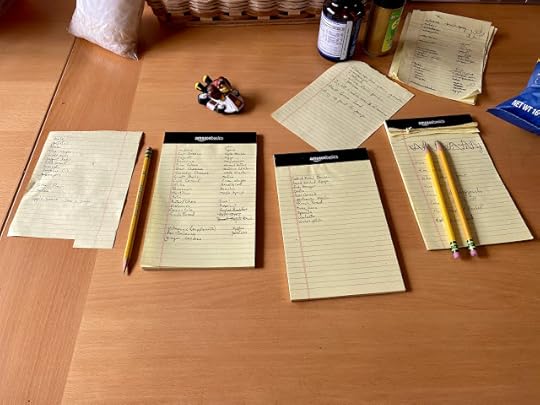 Canary-yellow writing pads and Ticonderoga #2 pencils, and I'm ready to begin the planning!Now as I sit at the kitchen table planning my route, my old habit of planning with tablets and pencil to make my lists prevails: a list for food, a list for last-minute preparations, lists for our children as they keep an eye on the house for the month we'll be gone. We're packing for our five-nights out, knowing that we'll have food stores available at our destination. We'll be driveway-mooching at Sandy's parents, hooking up to 120v electric power to run our 12v refrigerator and lights.
Canary-yellow writing pads and Ticonderoga #2 pencils, and I'm ready to begin the planning!Now as I sit at the kitchen table planning my route, my old habit of planning with tablets and pencil to make my lists prevails: a list for food, a list for last-minute preparations, lists for our children as they keep an eye on the house for the month we'll be gone. We're packing for our five-nights out, knowing that we'll have food stores available at our destination. We'll be driveway-mooching at Sandy's parents, hooking up to 120v electric power to run our 12v refrigerator and lights.The pencil scratches its way across the page, either adding an item or crossing one out. I'm glad I had the wheel-bearings packed last month at a local RV dealership. I've listened to the pounding of my little air compressor as I've topped of the trailer's tire pressure, and I've leaned on the torque wrench as I've checked that the wheel lugnuts are tight. I'll be de-winterizing the trailer next week. I was on my hands and knees yesterday, scrubbing the interior and removing my gear from this winter's 1-3 night local camping outings.
I've spent the time in front of the computer screen, studying Google Maps and locating possible campgrounds and RV parks for overnight stays on our trip. Since Sandy will need a strong phone signal for her online work, I've called the overnight sites to inquire about connectivity. Of course, I'm not naive enough to think all the information I receive will completely match our needs, but it's a beginning. After that, it's just take it one day at a time. Our longest mileage planned is a little over four hundred miles, with most days ranging between 250 miles and 325. We hope to leave early enough so that Sandy will have some time to work in the late afternoons if necessary.
I may very well be writing by hand in my daybook as we journey, skipping the computer and just taking notes and writing down impressions, details that I can include when I finally do post about our journey on my travel blog, Green Goddess Glamping. A few notes, a few photos, pleasant conversation with Sandy while on the road. Audiobooks have been strongly recommended for us while traveling, but Sandy and I are looking forward to just looking out the window and chatting. I've traveled before by myself on a trip off to the Carolinas, chronicled on my traveling blog under the label Green Goddess Expeditions.
I've researched and written before about writing and travelogues, so long ago, in fact, that the original blogs I read for inspiration and direction are now defunct, the links no longer active. Mine are still available, though, the most recent being "Travelogues and Tiny Trailer Travel." I'm excited to travel with my wife Sandy. The last time we traveled the Iowa-California route was from west to east when we drove a much loved yet worn 1975 Ford F-150 from my parents' home in California back to Iowa, a gift from my parents to my son. That was quite an adventure, considering the worn steering linkage and the lack of heater or windshield defroster. I remember how the engine would cut out and stall at stoplights on the continental divide because the old carburetor wasn't fuel injection, and the high-altitude air was too thin for the carburetor adjustments. I just feathered the accelerator, though, and once on the road we were okay, especially when we dropped out of the mountains. We made it, finding peace of mind on the trip by deciding that if the old orange "Pumpkin Wagon" broke down, we'd just have it towed to the nearest gas station, hand the owner registration title to someone willing to take it, and then take a bus home.
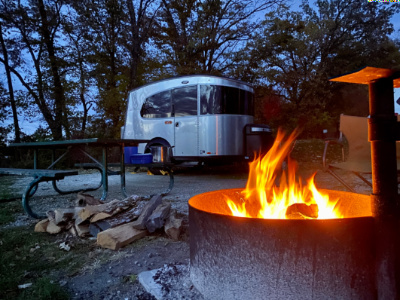 On an early winter overnighter with our Airstream BasecampThis trip should be more pleasant with our 2021 Airstream Basecamp and our 2018 Nissan Pathfinder (with only just under 18,000 miles on it). I'm looking forward to sharing our time together. Sandy even wants to learn how to drive while pulling the trailer, and I'm sure there are some not-so-busy stretches of highway on the trip that will provide her with some low-stress experience. Travelogue writing is a skill that I'm continually developing, and I plan to focus this trip on sharing those travel moments the best I can, those moments of flicking the turn signal and then pulling off the interstate freeway, heading for the night's campsite, having rolled down that long, lonesome highway, a song in my heart and my wife by my side.
On an early winter overnighter with our Airstream BasecampThis trip should be more pleasant with our 2021 Airstream Basecamp and our 2018 Nissan Pathfinder (with only just under 18,000 miles on it). I'm looking forward to sharing our time together. Sandy even wants to learn how to drive while pulling the trailer, and I'm sure there are some not-so-busy stretches of highway on the trip that will provide her with some low-stress experience. Travelogue writing is a skill that I'm continually developing, and I plan to focus this trip on sharing those travel moments the best I can, those moments of flicking the turn signal and then pulling off the interstate freeway, heading for the night's campsite, having rolled down that long, lonesome highway, a song in my heart and my wife by my side. Follow by email my travel blog, Green Goddess Glamping, if you'd like to read about my travel adventures. Follow this blog by signing up below if you'd like to learn more about my life of writing.
 #mc_embed_signup{background:#fff; clear:left; font:14px Helvetica,Arial,sans-serif; } /* Add your own Mailchimp form style overrides in your site stylesheet or in this style block. We recommend moving this block and the preceding CSS link to the HEAD of your HTML file. */ Follow by Email* indicates required Email Address * First Name Last Name (function($) {window.fnames = new Array(); window.ftypes = new Array();fnames[0]='EMAIL';ftypes[0]='email';fnames[1]='FNAME';ftypes[1]='text';fnames[2]='LNAME';ftypes[2]='text';fnames[3]='ADDRESS';ftypes[3]='address';fnames[4]='PHONE';ftypes[4]='phone';}(jQuery));var $mcj = jQuery.noConflict(true);
#mc_embed_signup{background:#fff; clear:left; font:14px Helvetica,Arial,sans-serif; } /* Add your own Mailchimp form style overrides in your site stylesheet or in this style block. We recommend moving this block and the preceding CSS link to the HEAD of your HTML file. */ Follow by Email* indicates required Email Address * First Name Last Name (function($) {window.fnames = new Array(); window.ftypes = new Array();fnames[0]='EMAIL';ftypes[0]='email';fnames[1]='FNAME';ftypes[1]='text';fnames[2]='LNAME';ftypes[2]='text';fnames[3]='ADDRESS';ftypes[3]='address';fnames[4]='PHONE';ftypes[4]='phone';}(jQuery));var $mcj = jQuery.noConflict(true);
March 15, 2022
The Cozy Mystery: Kick-A** Women in Corsets
 I've been reading a lot of cozy mysteries this winter--and enjoying them. My wife and I have formed a book club of two, and we've spent a good deal of time reading side by side or discussing the books we've read over a meal or cup of tea. Sometimes I'm a book or two ahead in a series, and sometimes my wife leads the way. Sometimes I've read a series that my wife's chosen to skip; sometimes it's the other way around. You might say we're easy with the cozy, or cozy with our easy-going reading schedule. However cute I want to get with my syntax, it's been a good winter in terms of our reading arrangement. We've read some good books and had some fun talks about those books.Therefore, it seems perfectly reasonable to share some of our conclusions regarding cozy mysteries beyond the two of us--hence, this article.
I've been reading a lot of cozy mysteries this winter--and enjoying them. My wife and I have formed a book club of two, and we've spent a good deal of time reading side by side or discussing the books we've read over a meal or cup of tea. Sometimes I'm a book or two ahead in a series, and sometimes my wife leads the way. Sometimes I've read a series that my wife's chosen to skip; sometimes it's the other way around. You might say we're easy with the cozy, or cozy with our easy-going reading schedule. However cute I want to get with my syntax, it's been a good winter in terms of our reading arrangement. We've read some good books and had some fun talks about those books.Therefore, it seems perfectly reasonable to share some of our conclusions regarding cozy mysteries beyond the two of us--hence, this article.The website cozy-mystery.com has published an article describing the qualities of a cozy mystery, "What Makes a Cozy Just That?" The identified characteristics in this article are as good as any other articles I've read. (Plus the website includes alphabetical lists of cozy authors.)
"The cozy mystery heroine is usually a very intuitive, bright woman." (A newer cozy series that features this is Sherry Thomas's Lady Sherlock series, which cleverly recreates the Sherlock Holmes mythos.)"The occupations of the amateur sleuths are very diverse"; that is to say, usually the female protagonist is not a professional private investigator. (In Rhys Bowen's Molly Murphy series, though, the protagonist does become a PI.)"Although the cozy mystery sleuth is usually not a medical examiner, detective, or police officer, a lot of times her best friend, husband, or significant other is." Anna Lee Huber's Lady Darby series features the "anatomist" plot feature.)"Cozy mysteries are considered “gentle” books… no graphic violence, no profanity, and no explicit sex." As the cozy article additionally mentions, authors sometimes push those boundaries. (Julie McElwain's Kendra Donovan series is an example of where the "gentle" mystery becomes more gritty. The character Kendra Donovan is an FBI agent who time travels to Regency England, where she solves murders.)"The cozy mystery puts an emphasis on plots and character development." This is why cozies become series--the journey of the main characters becomes as significant as solving the cases--or they become entwined. Often the romantic interest is a more modern-thinking male who assists the female protagonist, eschewing the social restrictions of the times regarding women. (A great example of this characteristic is Andrea Penrose's Wrexford and Sloane series, with one of the finest assembly of interesting characters of all the cozies I've read.)My wife and I have a few other comments regarding the cozy mystery. One is that I'm trying hard right now to remember if any of the cozy series my wife and I have read were written by men, but I'm coming up blank. I do know, though, that I've seen some male authors in the book lists I've read. One casual reference was to John Grisham, that his novel The Pelican Brief could fit the cozy definition, although it relies more on action than many cozies.Another point to make is that cozies repeatedly put the female protagonists in conflict with the restrictive sexist views of the times, whether it's Regency England, Victorian England, or American and Europe in the times prior to (or during) World War II. Most of the cozies I've read pit the female protagonist (and often the male partner) against the extreme limitations that were imposed upon women. The concept that women are only meant to be eye candy and heir-producers is a common conflict in the novels. A common theme is how far we've come with gender equality--and how we haven't come very far at all.
A third quality of cozy mysteries involves the literary device of anachronism, "a thing belonging or appropriate to a period other than that in which it exists." Although often used to mean something inordinately old-fashioned in a modern world, the anachronism in cozies is a modern, self-reliant, independent woman living in times where women are socially and legally without power. Often the female protagonists fight two conflicts at once: solving the murder mystery and struggling to act independently in a social milieu that represses a woman's independent spirit. Since issues of women's rights still resonate in today's modern world, this social conflict resonates for modern readers.
One of the pleasures my wife and I experience, now that we've read many cozy mysteries and quite a few series, to to determine and discuss how well the authors work within the boundaries of the cozy framework. Some authors are better at the social issues, some better at realistically portraying the romantic conflicts, and some shine at creating unique and interesting characters, including minor characters. This sub-genre of cozy mysteries is a safe and enjoyable environment to return to after a long day's work. The novel format rather than TV series medium highlights curiosity and mystery as a precursor to action, and in the end we are intellectually satisfied and not just stimulated by non-stop action.
Soon I'll be heading out this spring to garden, camp, and bike and hike. I'm looking forward to more activity and fresh air. It's been a good winter, though, in terms of reading. I've discovered new writers that are a pleasure to read, and I've learned a few things, too. Welcome to the world of the "gentle" mystery--a cutthroat world where "gentle" is a facade that must be maintained in order to exist and broken to survive.
 #mc_embed_signup{background:#fff; clear:left; font:14px Helvetica,Arial,sans-serif; } /* Add your own Mailchimp form style overrides in your site stylesheet or in this style block. We recommend moving this block and the preceding CSS link to the HEAD of your HTML file. */ Follow by Email* indicates required Email Address * First Name Last Name (function($) {window.fnames = new Array(); window.ftypes = new Array();fnames[0]='EMAIL';ftypes[0]='email';fnames[1]='FNAME';ftypes[1]='text';fnames[2]='LNAME';ftypes[2]='text';fnames[3]='ADDRESS';ftypes[3]='address';fnames[4]='PHONE';ftypes[4]='phone';}(jQuery));var $mcj = jQuery.noConflict(true);
#mc_embed_signup{background:#fff; clear:left; font:14px Helvetica,Arial,sans-serif; } /* Add your own Mailchimp form style overrides in your site stylesheet or in this style block. We recommend moving this block and the preceding CSS link to the HEAD of your HTML file. */ Follow by Email* indicates required Email Address * First Name Last Name (function($) {window.fnames = new Array(); window.ftypes = new Array();fnames[0]='EMAIL';ftypes[0]='email';fnames[1]='FNAME';ftypes[1]='text';fnames[2]='LNAME';ftypes[2]='text';fnames[3]='ADDRESS';ftypes[3]='address';fnames[4]='PHONE';ftypes[4]='phone';}(jQuery));var $mcj = jQuery.noConflict(true);
March 5, 2022
Read My New Flash Fiction Story Published at Every Day Fiction
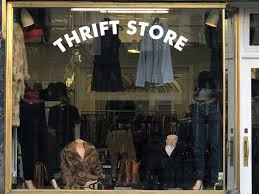
"He saw her reflection in the chipped mirror on the wall." That's the first sentence of my short story "Out with the Old," published at the online website magazine Every Day Fiction on March 3. Flash fiction of a bit over six hundred words in length, it's a story of reconciliation and rebirth.
I wrote the story in the dead of winter at a time when "the dead of winter" literally felt just like that, frozen and lifeless. Waking up before dawn with the story idea (and in the depth of winter it's not so hard to wake up before dawn), I sat down at my laptop and wrote the story in one sitting, finishing as the rose fingers of dawn caressed the eastern horizon, to paraphrase a Homeric epithet. The flash fiction story is not, of course, epic in length, nor is it an embodiment of a people as is Homer's Odyssey. However, writing the story was satisfying and even healing for me, representing my belief that we have great power over our lives, and that choosing the right action at the right time is one of the great benefits and opportunities that human consciousness provides.
"Old with the Old" was written in one sitting, revised a couple of times in the next week or so, and then revised on a few technical points, based on the Every Day Fiction editor's comments, then resubmitted. Every Day Fiction publishes one new flash fiction story every day of the year, paying its authors a whopping three dollars. Twelve years ago, I published another story for EDF, a Halloween story titled "Spider," which one reader's comment was "A great, creepy tale for Halloween!"
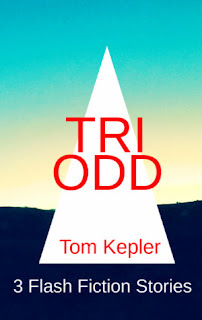
Three flash fiction stories are compiled in my Amazon ebook Tri Odd, which besides "Spider" also includes "Cull," a mildly macabre story about a retired English teacher (go figure!), and a science fiction genesis story, "In the Beginning." All three stories have been published in online magazines over the years.
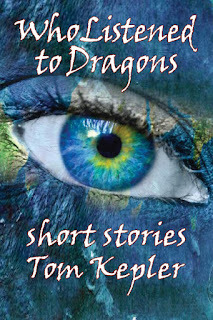
In addition to flash fiction, I also have published at Amazon another three short stories from my The Stone Dragon universe--Who Listened to Dragons. These short stories emerged from a map from The Stone Dragon novel. I looked at the map and asked myself, "I wonder what's happening there?" And thus the stories were born. I have several other unpublished stories written that are set in The Stone Dragon universe, and when enough are written, I'll publish a short story compilation, Tales of the Stone Dragon Inn.
Getting back to "Out with the Old," it's a story I submitted under the "Spring" category at EDF. It does have that sense of a breath of fresh air about it, one that I created for myself by writing the story--and if you're ready for a bit of spring yourself, follow the link to the story and enjoy!
 #mc_embed_signup{background:#fff; clear:left; font:14px Helvetica,Arial,sans-serif; } /* Add your own Mailchimp form style overrides in your site stylesheet or in this style block. We recommend moving this block and the preceding CSS link to the HEAD of your HTML file. */ Follow by Email* indicates required Email Address * First Name Last Name (function($) {window.fnames = new Array(); window.ftypes = new Array();fnames[0]='EMAIL';ftypes[0]='email';fnames[1]='FNAME';ftypes[1]='text';fnames[2]='LNAME';ftypes[2]='text';fnames[3]='ADDRESS';ftypes[3]='address';fnames[4]='PHONE';ftypes[4]='phone';}(jQuery));var $mcj = jQuery.noConflict(true);
#mc_embed_signup{background:#fff; clear:left; font:14px Helvetica,Arial,sans-serif; } /* Add your own Mailchimp form style overrides in your site stylesheet or in this style block. We recommend moving this block and the preceding CSS link to the HEAD of your HTML file. */ Follow by Email* indicates required Email Address * First Name Last Name (function($) {window.fnames = new Array(); window.ftypes = new Array();fnames[0]='EMAIL';ftypes[0]='email';fnames[1]='FNAME';ftypes[1]='text';fnames[2]='LNAME';ftypes[2]='text';fnames[3]='ADDRESS';ftypes[3]='address';fnames[4]='PHONE';ftypes[4]='phone';}(jQuery));var $mcj = jQuery.noConflict(true);
February 17, 2022
"70" Is a Compelling Number--and "Septuagenarian" Is a Mouthful
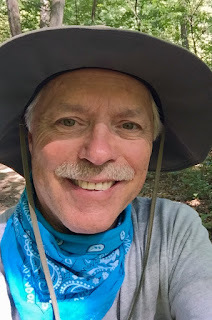 I graduated from high school in the 1970s and survived my 20s during that decade. It was a significant time, especially if we back the time up a little earlier to 1966 or 1968--political assassinations, the Vietnam War, the Civil Rights movement, the space program and a trip to the moon. Now, it's a half a century later and I'm celebrating another aspect of the 70s; I've now lived that long. February is that month where I become a septuagenarian, and just passing that mark leads me to some reflection. What I'm realizing is that many of my core beliefs have remained with me all my life and that now in my retirement I find them no less powerful and no less compelling. There is a certain timelessness in that--that what we are is not lessened by time. The times we may find distracting, but inside us there is a timelessness that remains.
I graduated from high school in the 1970s and survived my 20s during that decade. It was a significant time, especially if we back the time up a little earlier to 1966 or 1968--political assassinations, the Vietnam War, the Civil Rights movement, the space program and a trip to the moon. Now, it's a half a century later and I'm celebrating another aspect of the 70s; I've now lived that long. February is that month where I become a septuagenarian, and just passing that mark leads me to some reflection. What I'm realizing is that many of my core beliefs have remained with me all my life and that now in my retirement I find them no less powerful and no less compelling. There is a certain timelessness in that--that what we are is not lessened by time. The times we may find distracting, but inside us there is a timelessness that remains.I find myself increasingly compelled to listen. Yes, I still have things I want to say, ideas I want to share, but the necessity and need to listen has grown in my life. It was always there. I remember when I was eighteen years old on my high school's "senior skip day," a bunch of us guys got in our friend's old Packard and drove to Sacramento, California, (about an hour and a half drive) to visit one guy's parents and to watch the movie Woodstock. My friend was living with another friend's parents so that he could graduate his senior year with all of us. His parents had moved because of a job transfer that could not be postponed. Part of our excursion to Sacramento was a trip to a local park, which happened to be a gathering place for the homeless, many of them alcoholics. One Black man who called himself "Johnny Walker the shit talker" regaled us with stories, wowing our naive young selves with entertaining stories . . . and then he hit us up for our spare change, which we happily gave him. He asked for us to give, to us as a group and then individually without being pushy. When "Johnny" got to me, he said, "And how about you--you with the wise eyes?" Of course I contributed, but even then at eighteen years old, I realized what the man was saying. We had made eye contact several times during Johnny's story-telling, at a deeper level than that of audience and raconteur. There was the jive, and then there was the humanity. What I was doing was listening, with both my mind and my heart. I was including the old alcoholic in my world, considering him and the moment significant. We need to listen to one another, to include and absorb the perspectives of others into ours. I intuitively knew that when I was young and appreciate the importance of listening and inclusion more consciously now that I am older and have the benefit of my years of experiencing listening . . . and not listening . . . and the ramifications of each.
Researching a situation prior to engaging is increasingly important for me. Listening, of course, is an important aspect of research; in fact, it's primary research. In a world increasingly polarized, I want to bring balance to my decisions and actions. Research is an important way I learn, too. Therefore, by considering all sides of an issue, I can bring a more balanced approach to moving forward in my life, one that involves both intellect and emotions. Even after research and consideration if I find that my perspective hasn't changed, I might find a more positive and integrative way to act or speak. I'm thinking that this approach might seem "old person conservative," but to me it doesn't feel that way. There's a lot of creativity and discovery in considering many possibilities--and then there's the advantage of spending time in that field of all possibilities. Coming to a decision actually erects barriers and boundaries. Why rush to do that?
My family is a powerful defense against alienation and isolation. I am fortunate to be surrounded by my family--my wife, our blended family of three children (in their 30s), and our five grandchildren. I remember in my first years of public school teaching in the early 1980s that statistics determined that single parents or blended families had finally exceeded the number of nuclear families (mother, father, and genetic offspring). My mother was adopted, my son was adopted, and my entire life I've been taught and lived the truth that families are formed in many ways. "Family" is not a matter of blood but of spirit. My wife and I are fortunate to have our children and grandchildren living in the same town as us. However, I also realize that if this were not the case, we would create a family of friends and activities to keep us involved with people and engaged in vital activities. As Bob Dylan sang, "Those not busy being born are busy dying." My family provides me with an easy means of engagement with life--sometimes a bit too much, in fact! Then I pack up and go camping for a while. It's important, though, to live in the present and to not feel that our best years have already passed. I'm excited about my daily activities and my future hopes and plans. Having my family around provides many opportunities for participation in life. Extending family to its greatest scope, when "the world is my family," then how can there be alienation and isolation?
Freedom, variety, and creativity have increased in my life. Retirement has provided more time for me to choose my daily routine, to structure my time more around fulfillment rather than survival. I don't have a lot of needs. There isn't an outstanding list of things for me to buy and do--snowmobiles and trips to the geographic wonders of the world. It's not that I'm against owning a snowmobile or a new Ford F-150, or that I'm against visiting the Grand Canyon or Mayan ruins. The need isn't that great, though. I don't have a Santa's list of things I want or a bucket list of things I have to do before that bucket gets kicked. Possessions or accomplishments are not the ultimate summit of achievement. Fulfillment for me is an inner state, a state of being which cannot be located by gps or deed. Ralph Waldo Emerson observed that we cannot find a better world by traveling because we take our old perspectives along with us when we take off. I'm so grateful and fortunate to be practicing the Transcendental Meditation technique twice a day--and to have been doing so for forty-nine years. Being healthy and dynamic is a gift, but it is in many ways a gift that I have given myself by lowering my stress and developing my inner potential by practicing TM. I look forward to meeting the joys and challenges of each day, just as those in business enjoy the market, having first stopped by the bank.
We must be kind--both to ourselves and to others. When I was a full-time public school teacher, I once had a colleague tell me, "I was talking to a student the other day and the student mentioned you and the kind of teacher you are. He said, 'Mr. Kepler is a kind man.'" My response to my teacher-friend was, "What better legacy than that?" I once had a student--a 7th-grader--ask me about gay rights, whether being gay was right or wrong. I told her that many people had debated this question, and after listening to all the arguments for each side, I had finally realized that for me the "right/wrong" debate about others wasn't the most important point for me. What I realized was important for me was the following question: "Do I want to be the kind of person that makes other people suffer, that hurts the lives of others?" I told that young student that I chose not to make others suffer because of my beliefs, whatever they were. I felt this was a good answer for a public school teacher, where children come to school from families with many different perspectives and beliefs. Any parent with any belief would have a hard time condemning me for telling their children to be kind. It was also an American answer, too, because I was telling the student that we have a right to live our lives according to our principles, but others with different principles also have that right in the USA. Nurturing ourselves and others is not just a good idea, I think. It's an essential idea, a survival trait for our species. We are such an intelligent species, human beings, yet we have to temper our cleverness with wisdom. We have to look beyond our immediate desires and fit ourselves and our dreams and actions into the greater wisdom of the world.
What quality of life am I living? A current buzzword is "intentional" living, and although I'm not entirely comfortable with that word, since it seems to somehow and to somewhat disparage spontaneity, I do understand the basic idea that we should think about what we want and what's important to us in order to make choices that will be more fulfilling. Even Joseph Campbell's "follow your bliss" is in many ways advocating an intentional life--if I actually understand what people who are living intentional lives intend the word to signify. Some choices are not easy, perhaps because their impact on others creates complications, or perhaps because some choices require a level of self-scrutiny and honesty that cuts close to the bone--a kind of intentionality noir, as it were. I wonder, though, if the intentional life becomes easier in some ways as one grows older. Energy and activity slow a bit; lifestyle choices and routine expand a bit in retirement; and if one has any level of self-awareness, then experience will impact one's choice and priorities. Since wisdom is knowledge tempered by experience, perhaps an intentional life in one's elder years is simply learning to pause and wait for wisdom.
I think all the above are part and parcel of a meaningful life--being a part of our natural and social world, being true to ourselves yet still honoring and cherishing the differences in others, speaking out for what is true and right yet still allowing for differences in others. Integration of life, integration of opposites, holding the entire world within ourselves and not just one tiny part: this has been my lifetime goal, to live an integrated, balanced life of fulfillment. I feel I'm getting better at this as I go along, and I'm thinking that living the decade of my 70s will be just as exciting as when I lived my 20s. What about the fifty years in between those two decades? Fifty years is half a century, and yet somehow it feels like it's been no time at all. Let me reflect on that a bit--perhaps consciousness exists in time but is not of it? In the end, though, I tend to enjoy and pursue more simple, productive and nurturing activities. It's like Voltaire said at the end of his play Candide. As one translation put it regarding the frenzy of life--"That is very well and good, but let us tend our gardens."
 #mc_embed_signup{background:#fff; clear:left; font:14px Helvetica,Arial,sans-serif; } /* Add your own Mailchimp form style overrides in your site stylesheet or in this style block. We recommend moving this block and the preceding CSS link to the HEAD of your HTML file. */ Follow by Email* indicates required Email Address * First Name Last Name (function($) {window.fnames = new Array(); window.ftypes = new Array();fnames[0]='EMAIL';ftypes[0]='email';fnames[1]='FNAME';ftypes[1]='text';fnames[2]='LNAME';ftypes[2]='text';fnames[3]='ADDRESS';ftypes[3]='address';fnames[4]='PHONE';ftypes[4]='phone';}(jQuery));var $mcj = jQuery.noConflict(true);
#mc_embed_signup{background:#fff; clear:left; font:14px Helvetica,Arial,sans-serif; } /* Add your own Mailchimp form style overrides in your site stylesheet or in this style block. We recommend moving this block and the preceding CSS link to the HEAD of your HTML file. */ Follow by Email* indicates required Email Address * First Name Last Name (function($) {window.fnames = new Array(); window.ftypes = new Array();fnames[0]='EMAIL';ftypes[0]='email';fnames[1]='FNAME';ftypes[1]='text';fnames[2]='LNAME';ftypes[2]='text';fnames[3]='ADDRESS';ftypes[3]='address';fnames[4]='PHONE';ftypes[4]='phone';}(jQuery));var $mcj = jQuery.noConflict(true);
January 20, 2022
Deborah Harkness and her All Souls Trilogy (Discovery of Witches)
 The word verisimilitude means something has the appearance of being true or real. In literature, it means the author's world-building skills are such that the reader believes the reality of the work and is not pulled out of the "reading reality" by too great a stretch of the imagination. We, as readers, willingly suspend our disbelief and enter the fiction, wide-eyed and believing. Novelist and scholar Deborah E. Harkness in her fictional All Souls Trilogy creates a believable reality with credible characters that include witches, daemons, and vampires . . . plus a few charismatic plain old humans.
The word verisimilitude means something has the appearance of being true or real. In literature, it means the author's world-building skills are such that the reader believes the reality of the work and is not pulled out of the "reading reality" by too great a stretch of the imagination. We, as readers, willingly suspend our disbelief and enter the fiction, wide-eyed and believing. Novelist and scholar Deborah E. Harkness in her fictional All Souls Trilogy creates a believable reality with credible characters that include witches, daemons, and vampires . . . plus a few charismatic plain old humans. As the pitch for the trilogy (and the TV series A Discovery of Witches) emphasizes, magical creatures exist among us--in plain sight. Having read the trilogy a long time ago, I decided to try the Amazon Prime free first season of the TV series, especially when I realized that actor Matthew Goode was cast as the character Matthew Clairmont. I've always appreciated Goode's work when he's popped up on the screen through the years. In many ways the TV series is just as enjoyable if not more so than the books, the drama playing out in the series without shading toward melodrama.
Finishing the first season lickety-split (it is winter outside, after all, and conducive to sitting on the sofa), my wife and I immediately bought the second season via Amazon streaming. Then when we finished and decided to buy the third season, we discovered that it was still streaming week by week. We decided we didn't want to subscribe to another streaming service (available via Amazon), so we tried out Plan B and decided to just read the third book of the trilogy. Then we decided that rather than waiting and checking the book out of our local public library, we would choose immediate wish fulfillement and bought the Kindle ebook. I'm happy to say that the move from TV series to book was seamless, with just a few minor changes noticeable.
I've ripped through the third book of the trilogy and now have the fourth book, Time's Convert, on hold at the library, which I'll check out today. The fourth book continues the saga but isn't necessary for closure, which Harkness supplies at the end of the third book of the trilogy, The Book of Life. I've enjoyed sharing this trilogy with my wife--our little book club of two. We're both happy with this series, which manages to combine magic with romance without descending into "bodice-ripping," gratuitous explication. And, of course, when the third season of the series is available as a unit, we'll enjoy that, too. In fact, we've discovered that the first two seasons of A Discovery of Witches is available at our good ol' public library, so when they acquire the third, we're good to go! #mc_embed_signup{background:#fff; clear:left; font:14px Helvetica,Arial,sans-serif; } /* Add your own Mailchimp form style overrides in your site stylesheet or in this style block. We recommend moving this block and the preceding CSS link to the HEAD of your HTML file. */ Follow by Email* indicates required Email Address * First Name Last Name (function($) {window.fnames = new Array(); window.ftypes = new Array();fnames[0]='EMAIL';ftypes[0]='email';fnames[1]='FNAME';ftypes[1]='text';fnames[2]='LNAME';ftypes[2]='text';fnames[3]='ADDRESS';ftypes[3]='address';fnames[4]='PHONE';ftypes[4]='phone';}(jQuery));var $mcj = jQuery.noConflict(true);
#mc_embed_signup{background:#fff; clear:left; font:14px Helvetica,Arial,sans-serif; } /* Add your own Mailchimp form style overrides in your site stylesheet or in this style block. We recommend moving this block and the preceding CSS link to the HEAD of your HTML file. */ Follow by Email* indicates required Email Address * First Name Last Name (function($) {window.fnames = new Array(); window.ftypes = new Array();fnames[0]='EMAIL';ftypes[0]='email';fnames[1]='FNAME';ftypes[1]='text';fnames[2]='LNAME';ftypes[2]='text';fnames[3]='ADDRESS';ftypes[3]='address';fnames[4]='PHONE';ftypes[4]='phone';}(jQuery));var $mcj = jQuery.noConflict(true);



